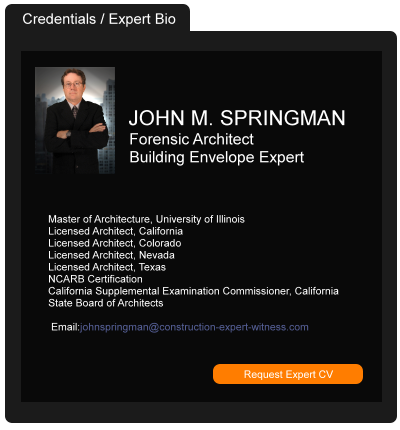City Drops Impact Fees to Encourage Commercial Development
November 08, 2013 —
CDJ STAFFThe Orvido, Florida city council wants to encourage commercial development, and they’re willing to do it by discouraging residential development. The impact fees for commercial buildings have dropped sharply, the Orlando Sentinel notes that for a 50,000 square-foot office building, the city is reducing the impact fee from $2,890 to $1,575, a drop of $1,313, nearly half.
Meanwhile, the impact fee for single-family homes has seen an increase of seven percent, going from $3,195 to $3.433. The city is clear about its reasons. “We’re very heavy on the residential side. We want to have more high-paying jobs come into the city,” said Keith Britton, a member of the council.
Read the court decisionRead the full story...Reprinted courtesy of
Steps to Defending against Construction Defect Lawsuits
July 21, 2011 —
CDJ STAFFWriting in Claims Journal, Bryan Rendzio notes that the decline in construction has not been matched by a decline in construction defect lawsuits over condominiums. He reviews the ways in which lawyers representing developers can help protect their clients. He identifies four important considerations in defending developers from claims of construction defects.
�He advocates a careful review of the contract. “Under a breach of contract claim, the insured’s duties to the party who brought the claim against the insured flow from the contract. Commonly, construction contracts limit the scope of recoverable damages, such as by waiving consequential damages.’
�The next step, according to Rendzio is to check of a settlement agreement is already in place, noting that these are “a familiar occurrence in the construction industry, regardless of any lawsuits having been filed.”
�He considers the statute of repose “the single-most decisive weapon an insured possesses in its arsenal during a condo defect lawsuit.” He notes that no lawsuits can be brought for construction defects after the end specified by the statute of repose, and if a lawsuit is brought beforehand, no additional parties can be named once the statute has taken effect.
�Finally, he warns adjusters to be suspicious when a condo association requests contractual indemnification. He notes that the pitfall in this is that developers and the subsequent condominium association often have similar names, given the theoretical example of a condo project built by “Fake Lakes LLC” and later run by the “Fake Lakes Condominium Association.” Writing in regards to Florida law, he notes that condominium associations do not have successor interest in contracts developers made with contractors.
Read the full story…
Read the court decisionRead the full story...Reprinted courtesy of
Lewis Brisbois Ranks Among Top 25 Firms on NLJ’s 2021 Women in Law Scorecard
July 25, 2021 —
Jana Lubert - Lewis BrisboisLewis Brisbois has been ranked among the top 25 law firms included in the National Law Journal's (NLJ) 2021 Women in Law Scorecard (Women’s Scorecard), moving up from 27th place to 23rd place this year. In addition, of the top 25 firms in the Women’s Scorecard, Lewis Brisbois had the highest number of female minority partners.
The Women’s Scorecard is produced as part of the annual NLJ 500 firm head count report, and only the largest 350 firms are eligible to be included on the scorecard. A firm’s score is determined by adding the percentage of female attorneys and percentage of female partners. Diversity staffing counts were based on a firm’s average full-time attorneys in 2020, excluding contract and temporary attorneys.
Read the court decisionRead the full story...Reprinted courtesy of
Jana Lubert, Lewis BrisboisMs. Lubert may be contacted at
Jana.Lubert@lewisbrisbois.com
The Secret to an OSHA Inspection
December 02, 2015 —
Craig Martin – Construction Contractor AdvisorWouldn’t it be nice to know ahead of time what an OSHA inspector will be looking for when he comes to your work site? Well, I know the secret. And, it’s not really a secret. Just look at OSHA’s top ten citation standards and it becomes quite clear.
In 2015, OSHA’s top ten most frequently cited violations are:
1. Fall protection (C)
2. Hazard communication
3. Scaffolding (C)
Read the court decisionRead the full story...Reprinted courtesy of
Craig Martin, Lamson, Dugan and Murray, LLPMr. Martin may be contacted at
cmartin@ldmlaw.com
More (and Simpler) Options Under New Oregon Retention Law
October 21, 2024 —
Michael Yelle - Ahlers Cressman & Sleight PLLCSimilar to the changes made by the Washington Legislature last year, the Oregon Legislature recently changed its retention law. Oregon public works agencies and large commercial project owners are now required to accept surety bonds in lieu of withholding retainage on construction projects. There is also no longer a requirement to deposit retention funds in an interest-bearing escrow account.
The owner or public agency must accept the bond in lieu of retainage unless specific grounds exist. For example, public agencies must find there is “good cause” for rejection of the bond based on the “unique project circumstances. Private owners have less discretion to reject a bond and if the bond meets the statutory requirements, per ORS 701.435(1)(a) “the owner and lender shall accept” the bond “in lieu of all or any portion of the retainage…”
Courts have not analyzed when “good cause” exists for public agencies to reject bonds or exactly what will allow a private owner to reject a bond. However, an agency or owner cannot have a general policy to reject retention bonds. The statute does not provide next steps if the contractor disagrees with a decision to reject the bond. It may be necessary to proceed under the contract’s dispute resolution procedure or it may be more appropriate to take the issue directly to the courts.
Read the court decisionRead the full story...Reprinted courtesy of
Michael Yelle, Ahlers Cressman & Sleight PLLCMr. Yelle may be contacted at
michael.yelle@acslawyers.com
Elon Musk's Boring Co. Is Feuding With Texas Over a Driveway
July 25, 2022 —
Sarah McBride - BloombergWhile Elon Musk is publicly making a big deal about moving to Texas and cozying up to the governor, behind the scenes his tunnel-building venture, Boring Co., is wrangling with local authorities in the state over a host of seemingly mundane permitting issues.
Since Boring bought land last May to create a research and development center in Bastrop, Texas, a rural area outside Austin, the company has put workers up on mobile homes at the site without authorized sewage facilities, failed to get air and stormwater permits and built a driveway without first getting official approval, according to documents obtained by Bloomberg News through a public records request.
The company’s dealings with Bastrop are yet another illustration of how Musk’s businesses often push the boundaries of or simply ignore regulations that bind other companies. In recent years his Tesla Inc. restarted production at its Fremont plant in defiance of pandemic rules to stay closed, Boring tried to build a tunnel in Los Angeles without going through an environmental review process and the US Securities and Exchange Commission is examining the disclosure of Musk’s stake in Twitter Inc.
Read the court decisionRead the full story...Reprinted courtesy of
Sarah McBride, Bloomberg
Critical Updates in Builders Risk Claim Recovery: Staying Ahead of the "Satisfactory State" Argument and Getting the Most Out of LEG 3
December 11, 2023 —
Gregory D. Podolak & Cheryl L. Kozdrey - Saxe Doernberger & Vita, P.C.Builders risk claims routinely involve complicated and aggressive debate about the interplay between covered physical loss and uncovered faulty work. However, denials on this front have recently experienced a noticeable uptick in frequency, creativity, and aggressiveness. The insurer arguments concentrate in two key areas with a common theme – that any damage associated with a construction defect is not covered:
- Defective construction does not qualify as a “physical” loss to trigger the insuring agreement; and
- Any natural results of defective construction are excluded as faulty workmanship, even with favorable LEG 3 or similar language.
Neither of these arguments should impede access to coverage in the majority of scenarios. To ensure as much, it is incumbent on the savvy policyholder to understand the insurer tactics, be prepared to spot them early, and have thoughtful counter positions at the ready to address them decisively.
Reprinted courtesy of
Gregory D. Podolak, Saxe Doernberger & Vita, P.C. and
Cheryl L. Kozdrey, Saxe Doernberger & Vita, P.C.
Mr. Podolak may be contacted at GPodolak@sdvlaw.com
Ms. Kozdrey may be contacted at CKozdrey@sdvlaw.com
Read the court decisionRead the full story...Reprinted courtesy of
Illinois Supreme Court Holds That the Implied Warranty of Habitability Does Not Extend to Subcontractors
March 04, 2019 —
Michael J. Ciamaichelo - The Subrogation StrategistThe implied warranty of habitability allows a homeowner to recover damages for latent defects that interfere with the intended use of a home. In Sienna Court Condo. Ass’n v. Champion Aluminum Corp., 2018 IL 122022, 2018 Ill. LEXIS 1244 (2018), the Supreme Court of Illinois held that buyers of new homes cannot assert claims for breach of the implied warranty of habitability against subcontractors involved in the construction of the homes because the subcontractors have no contractual relationship with the homeowners and the damages are purely economic. As the court explained, the implied warranty of habitability is a creature of contract (not tort) and, therefore, only exists when there is contractual privity between the defendants and the homeowners.
In Sienna, a group of condominium unit owners alleged that their new homes contained latent construction defects and asserted claims against the various parties involved in the construction and sale of the homes, including claims against the defendant subcontractors for breach of the implied warranty of habitability. The plaintiffs contracted with the property developer to purchase the homes, but the plaintiffs had no contractual relationship with the subcontractors involved in the construction of the homes. The Sienna court, overturning the decisions of the trial court and the appellate court, granted the subcontractors’ joint motion to dismiss the plaintiff’s claims for the implied warranty of habitability because the plaintiffs had no contractual relationship with the subcontractors and the damages were purely economic.
Read the court decisionRead the full story...Reprinted courtesy of
Michael J. Ciamaichelo, White and Williams LLPMr. Ciamaichelo may be contacted at
ciamaichelom@whiteandwilliams.com


































































